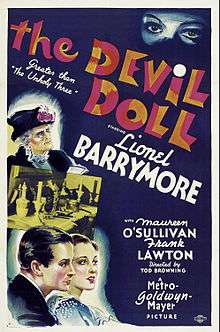The Devil-Doll
| The Devil-Doll | |
|---|---|
 | |
| Directed by | Tod Browning |
| Produced by | Edward J. Mannix |
| Written by |
|
| Starring | |
| Music by | Franz Waxman |
| Cinematography | Leonard Smith |
| Edited by | Frederick Y. Smith |
| Distributed by | Metro-Goldwyn-Mayer |
Release dates |
|
Running time | 79 minutes |
| Country | United States |
| Language | English |
.webm.jpg)
The Devil-Doll (1936) is a horror film directed by Tod Browning and starring a cross-dressing Lionel Barrymore and Maureen O'Sullivan as his daughter, Lorraine Lavond. The movie was adapted from the novel Burn Witch Burn! (1932) by Abraham Merritt.[1]
Plot
Paul Lavond (Barrymore), who was wrongly convicted of robbing his own Paris bank and killing a night watchman more than seventeen years ago, escapes Devil's Island with Marcel (Henry B. Walthall), a scientist who is trying to create a formula to reduce people to one-sixth of their original size. The intended purpose of the formula is to make the Earth's limited resources last longer for an ever-growing population. The scientist dies after their escape.
Lavond joins the scientist's widow, Malita (Rafaela Ottiano), and decides to use the shrinking technique to obtain revenge on the three former business associates who had framed him and to vindicate himself. He returns to Paris and disguises himself as an old woman that sells lifelike dolls. He shrinks a young girl and one of his former associates to infiltrate the homes of the other two former associates, paralyzing one.
When the final associate confesses before he is attacked, Lavond clears his name and secures the future happiness of his estranged daughter, Lorraine (O'Sullivan), in the process. Malita isn't satisfied, and wants to continue to use the formula to carry on her husband's work. She tries to kill Paul when he announces that he is finished with their partnership, having accomplished all he intended, but she blows up their lab, killing herself.
Paul tells Toto, Lorraine's fiancé, about what happened. He meets his daughter, pretending to be the deceased Marcel. He tells Lorraine that Paul Lavond died during their escape from prison, but that he loved her very much. Lavond then departs, to an uncertain fate.
Cast
- Lionel Barrymore as Paul Lavond
- Maureen O'Sullivan as Lorraine Lavond
- Frank Lawton as Toto
- Rafaela Ottiano as Malita
- Robert Greig as Emil Coulvet
- Lucy Beaumont as Madame Lavond
- Henry B. Walthall as Marcel
- Grace Ford as Lachna
- Pedro de Cordoba as Charles Matin
- Arthur Hohl as Victor Radin
- Juanita Quigley as Marguerite Coulvet
- Claire Du Brey as Madame Coulvet (as Claire du Brey)
- Rollo Lloyd as Detective Maurice
Reception
Thrilling Wonder Stories termed the film a "disappointment", calling it :a run-of-the-mill thriller which does not attempt to recapture the unique fantasy of Merritt's novel".[2]
See also
References
External links
| Wikimedia Commons has media related to The Devil-Doll. |
- The Devil-Doll at the Internet Movie Database
- The Devil-Doll at AllMovie
- The Devil-Doll at the TCM Movie Database